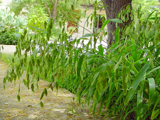Native Plants

Q. Who is Mr. Smarty Plants?
A: There are those who suspect Wildflower Center volunteers are the culpable and capable culprits. Yet, others think staff members play some, albeit small, role. You can torture us with your plant questions, but we will never reveal the Green Guru's secret identity.
Did you know you can access the Native Plant Information Network with your web-enabled smartphone?
Ask Mr. Smarty Plants is a free service provided by the staff and volunteers at the Lady Bird Johnson Wildflower Center.

rate this answer
Saturday - January 09, 2010
From: Aiken, SC
Region: Southeast
Topic: Erosion Control, Grasses or Grass-like
Title: Plants to stabilize a steep bank in South Carolina
Answered by: Nan Hampton
QUESTION:
I would like to use native plantings to stabilize a steep bank. The bank is on the side of the gravel road I cut back into the woods and around a 36" pipe going under the road to allow the free flow of a spring head. The bank is only about 5' tall on both sides and 50' long. I headed the ends of the pipe off and put rye grass all over it to get through the winter but with all the rain it is not helping around the pipe. I am looking for something to fit in with the natural look of the woods and grow naturally. I have spent some time on the Recommended Species page but have not been able to find anything. Thank you.ANSWER:
With all the rain, it sounds as if you would benefit from using some sort of erosion control blanket, especially around the pipe. The erosion-control fabric works by slowing the runoff water and allowing sediments to fall out rather than be washed away. Seeds are sown under the erosion-control material and grow up through the matting when they germinate. You can insert plants into the soil by cutting through the matting. The roots of the plants that are growing through the erosion-control material anchor the soil to stop the erosion. If you use erosion-control blankets made of biodegrable material, they will eventually disappear leaving the plants to control the problem. You can read about a stream bank stabilization project implemented by the Department of Environmental Services, Arlington, Viriginia. Although their problem was not exactly the same as yours, they did use the erosion control blankets with great success.
Now for plants to use for erosion control, grasses are ideal because their extensive fibrous root systems hold the soil in place. Here are some native grasses that are attractive and grow well in South Carolina:
Sorghastrum nutans (Indiangrass)
Chasmanthium latifolium (Inland sea oats)
Schizachyrium scoparium (little bluestem)
Muhlenbergia capillaris (hairawn muhly)
Andropogon gerardii (big bluestem)
Panicum virgatum (switchgrass)
Here are some other plants that should work well:
Parthenocissus quinquefolia (Virginia creeper)
Ceanothus americanus (New Jersey tea)
Coreopsis lanceolata (lanceleaf tickseed)
Rudbeckia hirta (blackeyed Susan)
Vaccinium stamineum (deerberry)
Vaccinium pallidum (Blue Ridge blueberry) and here are photos
Rubus trivialis (southern dewberry)
All of the above plants are native to Aiken County, South Carolina but since I don't know the particulars of your site (e.g., soil type, soil moisture, available sunlight), you need to check the "Growing Conditions" on each of the species' pages to make sure that they match those of your site.
Here are photos from our Image Gallery for the plants listed above:
More Erosion Control Questions
Erosion control near creek in Kansas City, MO
July 26, 2008 - I'm looking for something to plant to help stop erosion on my property. The spot I have in mind is on a slight natural grade heading toward the creek at the back of my property. Any ideas on what t...
view the full question and answer
Landscaping on South Padre Island
June 07, 2008 - I'm in charge of landscaping at my beachfront condo in South Padre Island and find the wind, salt air, and heat challenging for growing almost anything. We would like to incorporate native plants, b...
view the full question and answer
Restoring tornado-damaged property in Alexander City AL
January 29, 2012 - Dear Mr Smartypants,
We were struck by the outbreak of tornadoes last spring and our wonderful woods are now unsightly sloping pastures with erosion problems.. many stumps and coils of roots. We are...
view the full question and answer
Groundcover for erosion control
July 22, 2008 - I have a sloped area in my back yard where we need to plant some erosion control plants. The area is above a large (100 foot long x 4 foot tall) stone wall and another smaller wall of natural stone. ...
view the full question and answer
California native bunch grasses good for erosion control
November 21, 2010 - In response to your answer about deep rooted native plants good for erosion control, don't forget to include native bunchgrasses. here in California, our bunchgrasses have roots that go 10ft, 20ft de...
view the full question and answer
| Support the Wildflower Center by Donating Online or Becoming a Member today. |

